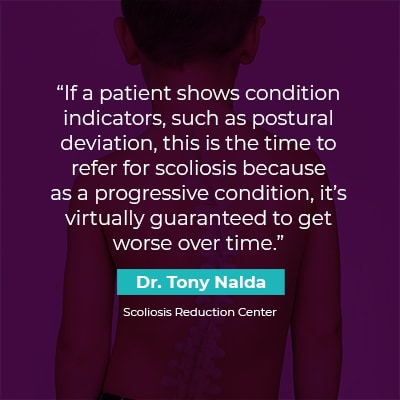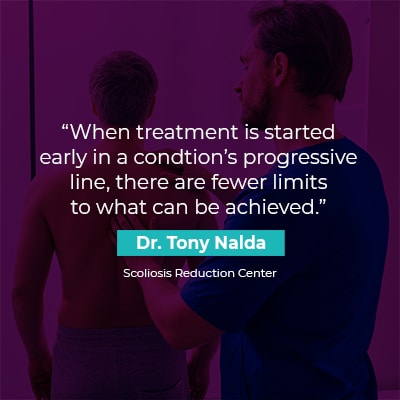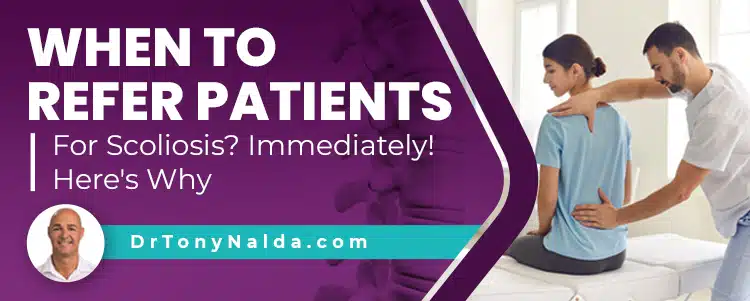Scoliosis can be a complex condition to treat, not just because it ranges widely in severity and there are multiple different types; it’s also a progressive spinal condition, meaning its nature is to worsen over time. As scoliosis only gets harder to treat as progression occurs, being proactive and starting treatment as close to the time of diagnosis as possible is associated with better treatment results.
As scoliosis is a progressive condition, not just how it’s treated, but when treatment is started can have far-reaching effects. If a patient shows condition indicators, or parents notice telltale signs in a child, the best time to seek professional guidance and treatment is always now.
Before getting to when to refer patients for scoliosis, let’s first discuss how a diagnosis is reached.
Diagnosing Scoliosis
When it comes to diagnosing scoliosis, there are a number of parameters that have to be met.
Scoliosis involves the development of an unnatural lateral (side-to-side) spinal curve, with rotation, and it’s the unnatural twist that makes scoliosis a 3-dimensional condition.
In addition, a scoliotic curve has to have a minimum Cobb angle of 10 degrees, and a patient’s Cobb angle is determined during X-ray by drawing lines from the tops and bottoms of the curve’s most-tilted vertebrae; the resulting angle is expressed in degrees.
When the spine’s natural and healthy curves are in place, its vertebrae are aligned as they should be, but if one or more become unnaturally tilted, this shifts the spine out of alignment, causing a number of issues.
A patient’s Cobb angle tells me how far out of alignment a scoliotic spine is, and places conditions on a severity scale of mild to moderate and severe to very severe.
The higher the Cobb angle, the more severe the condition, and the more noticeable its effects are likely to be.
As a progressive condition, it’s important for patients to understand that where their scoliosis is at the time of diagnosis isn’t indicative of where it will stay; only proactive treatment can work towards counteracting the condition’s progressive nature.
Scoliosis progression, and how it affects treatment, is what makes it so important to refer patients immediately for scoliosis.
When to Refer for Scoliosis: Early Detection Benefits
While there are never treatment guarantees, early detection, when responded to with early intervention, does increase the likelihood of treatment success.
As scoliosis progresses, the unnatural spinal curve is getting larger, making the spine more rigid, less responsive to treatment, and decreasing spinal flexibility.
When there is a significant loss in spinal flexibility and range of motion, it can interfere with a patient’s ability to perform certain therapeutic exercises that are a key facet of treatment.
So why not start treatment as close to the time of diagnosis as possible? This is going to be when the spine is at its most responsive, and when treatment success is the most likely.

If a patient shows condition indicators, such as postural deviation, this is the time to refer for scoliosis because as a progressive condition, it’s virtually guaranteed to get worse over time.
Performing screening tests can help determine if a patient has condition indicators that warrant the need for further testing.
The Adam’s forward bend test is the gold standard when it comes to checking for condition indicators.
A patient will need to bend forward at a 90-degree angle as if trying to touch their toes, and in this position, the spine is highly visible, as are any asymmetries.
Now, there are different types of scoliosis, but the most prevalent is adolescent idiopathic scoliosis (AIS), diagnosed between the ages of 10 and 18, and the main sign of AIS is postural deviation.
The condition’s uneven forces disrupt the body’s overall symmetry, so uneven shoulders and hips are often the earliest signs of scoliosis.
A common question I’m asked is “what is atr in scoliosis screening,” and atr represents the angle of trunk rotation, which refers to how much the spine twists, in addition to bending unnaturally to the side.
A patient’s angle of trunk rotation is a factor that shapes how painful a condition is, in addition to how noticeably it affects posture.
When combined with the use of a Scoliometer, the angle of trunk rotation can also be determined, and if there are condition indicators, a patient is ready to be referred to a specialist for further testing and treatment.
Treatment Options
The thing about scoliosis is that particularly in mild cases, the condition isn’t always easy to spot, which is why referring for scoliosis immediately is always best; just because a patient is diagnosed at a certain time doesn’t necessarily indicate when the scoliosis first developed.
In fact, the most common type of scoliosis to affect adults is idiopathic scoliosis, and these cases involve adolescents who had adolescent idiopathic scoliosis but were unaware so were neither diagnosed, nor treated, and the condition progressed with maturity and into adulthood.
The condition doesn’t become compressive until adulthood, which is why it’s not commonly painful for children (another reason early detection isn’t always easy), but pain is the main symptom in adults.
So it’s not uncommon for patients to be living with scoliosis for years before the condition progresses enough to start causing noticeable symptoms and/or when it becomes compressive and painful.
While no one wants to experience pain, it does serve a purpose and tells us that something is wrong inside the body.
So if a patient comes in with concerns they have scoliosis, don’t hesitate to perform an Adam’s forward bend test and refer them to a specialist for an X-ray to confirm what’s happening in and around a patient’s spine.
There are two main scoliosis treatment approaches for patients to choose between: traditional and conservative.
Traditional Scoliosis Treatment
The traditional scoliosis treatment approach was the dominant approach for many years, but that doesn’t mean it’s the best, or the most effective.
Traditional treatment offers a surgical response, so it funnels patients towards spinal fusion surgery.
Spinal fusion involves fusing a curve’s most-tilted vertebrae into one solid bone to eliminate movement (progression) in the area, and in most cases, rods are attached to the spine to hold it in place; hardware attached is permanent.
Spinal fusion can successfully straighten a bent spine, but it can come at the cost of the spine’s strength and function.
The spine’s design is based on movement, so fusing its vertebrae is contrary to its movement-based design, and this affects the spine and its surrounding muscles.
A spine that’s fused is one that’s less flexible, often has a reduced range of motion, and this result disappoints many patients and can affect quality of life.
Conservative Scoliosis Treatment
Here at the Scoliosis Reduction Center®, I value proactive treatment started as close to the time of diagnosis as possible as this is associated with better treatment results.
I combine multiple different types of treatment, such as chiropractic care, physical therapy, corrective bracing, and rehabilitation to impact conditions on every level.

When treatment is started early in a condtion’s progressive line, there are fewer limits to what can be achieved.
Through chiropractic care that involves a number of techniques and manual adjustments, I can work towards achieving a curvature reduction on a structural level, and as a structural condition, this is exactly where it needs to be impacted the most.
Through corrective bracing, known to be particularly effective on growing spines, I can augment corrective treatment results by pushing the spine into a corrective position.
As it’s not just the spine that maintains its natural curves and alignment, but also its surrounding muscles that provide it with support and stabilization, increasing core strength can mean a spine that’s being optimally supported.
Physical therapy can also address any related muscle imbalances and improve posture and brain-body communication.
Rehabilitating the spine involves a series of custom-prescribed home exercises to help further stabilize the spine for long-term sustainable treatment results.
So when it comes to when to refer to scoliosis to ortho, the answer is as soon as possible; remember, when a condition first becomes noticeable is rarely aligned with its onset.
Conclusion
If a patient or individual notices some signs of scoliosis, it’s important to refer for scoliosis immediately; as a progressive condition, there are a number of benefits associated with early detection and intervention.
Scoliosis ranges widely from mild to moderate and severe to very severe, and the more severe a condition becomes, the more likely its continued progression is, in addition to making it more complex to treat.
Small scoliosis curves are more flexible and are going to respond to treatment better, meaning that even a mild case should be referred to a specialist so an official diagnosis can be reached and proactive treatment can be started.
Patients should be immediately referred, and this is especially the case with young patients because although we don’t always know what causes scoliosis to develop, we do know what triggers it to progress: growth and development.
Young patients, particularly adolescents, who are in or entering into the stage of puberty are at risk for rapid-phase progression, so once again, an immediate referral is always best.
When treated proactively, scoliosis doesn’t have to be a limiting condition, and condition effects and potential complications can be minimized.




